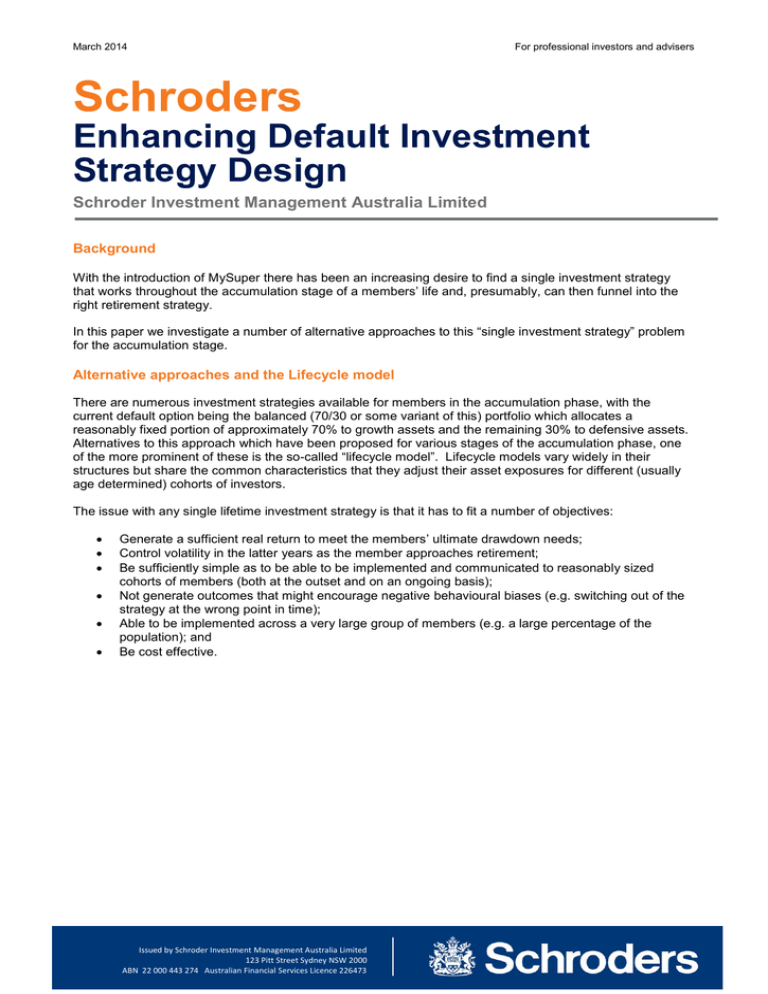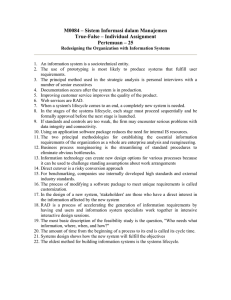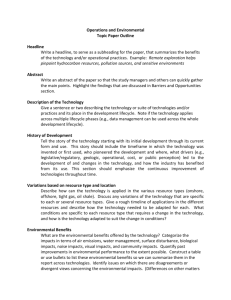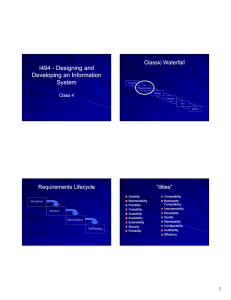Schroders Enhancing Default Investment Strategy Design
advertisement

March 2014 For professional investors and advisers Schroders Enhancing Default Investment Strategy Design Schroder Investment Management Australia Limited Background With the introduction of MySuper there has been an increasing desire to find a single investment strategy that works throughout the accumulation stage of a members’ life and, presumably, can then funnel into the right retirement strategy. In this paper we investigate a number of alternative approaches to this “single investment strategy” problem for the accumulation stage. Alternative approaches and the Lifecycle model There are numerous investment strategies available for members in the accumulation phase, with the current default option being the balanced (70/30 or some variant of this) portfolio which allocates a reasonably fixed portion of approximately 70% to growth assets and the remaining 30% to defensive assets. Alternatives to this approach which have been proposed for various stages of the accumulation phase, one of the more prominent of these is the so-called “lifecycle model”. Lifecycle models vary widely in their structures but share the common characteristics that they adjust their asset exposures for different (usually age determined) cohorts of investors. The issue with any single lifetime investment strategy is that it has to fit a number of objectives: Generate a sufficient real return to meet the members’ ultimate drawdown needs; Control volatility in the latter years as the member approaches retirement; Be sufficiently simple as to be able to be implemented and communicated to reasonably sized cohorts of members (both at the outset and on an ongoing basis); Not generate outcomes that might encourage negative behavioural biases (e.g. switching out of the strategy at the wrong point in time); Able to be implemented across a very large group of members (e.g. a large percentage of the population); and Be cost effective. Issued by Schroder Investment Management Australia Limited 123 Pitt Street Sydney NSW 2000 ABN 22 000 443 274 Australian Financial Services Licence 226473 March 2014 For professional investors and advisers The underlying logic of a typical Lifecycle model is to allocate between growth and defensive assets depending on how close a member is from their retirement. Younger members, given their longer investment horizon and ability to recover from market down turns, have a greater exposure to growth assets – predominantly equities. As a member approaches retirement, their portfolio undertakes a gradual transition along a “glide-path” away from growth assets and towards defensive assets in order to protect the accumulated wealth. The aim of this is to increase the degree of certainty in the outcomes a member is able to achieve and to prevent extreme drawdown scenarios for those who are close to retirement. Intuitively, the Lifecycle investment model makes sense as it reduces “risk” (defined as exposure to growth assets) as the member ages. In reality, the member ends up with an exposure throughout their lifetime which is on average 70/30 (or thereabouts) but changes significantly with age. Another alternative is to reconsider the 70/30 portfolio and allow greater variation in the exposures coincident with asset class return and risk expectations. We will refer to these approaches as valuation based asset allocation approaches. While through time the investor (we use the term investor interchangeably with member) also has an average exposure of around 70/30, the weights can vary significantly from that. In this case, we could suggest that the weights vary according to risk, but where risk is defined as the potential for loss from an asset class, not a function of the asset class name. The advantage of these approaches, along with the 70/30 portfolio, is that they are all relatively simple, cost effective and, based on history, have generated reasonable real outcomes through time. The purpose of this paper is to investigate these alternatives and determine the extent to which they can really meet the requirements for a single investment strategy in the accumulation phase. What is the risk? The primary aim of a single investment strategy is to generate decent outcomes across different member cohorts (i.e. some form of predictability for members joining at different times). In this regard, there are two major risks that members face: 1. “Sequencing” risk – given that members have different levels of capital at different times (in general they have more capital as they approach retirement), the impact of the investment return and timing of that investment return can have a substantial impact on the outcome. 2. “Pricing” risk – asset classes can go through prolonged (e.g. 10 years +) periods of sub-par returns. This is generally a function of buying an asset class when it is expensive. The aim of the Lifecycle model is to lower the “risks” for members approaching retirement by setting them along a glide-path allocation. Thus, the model makes the implicit assumption that risk is measured by a portfolio’s allocation to growth assets ie lower equities = lower risk. While the Lifecycle model does usually result in lower portfolio volatility for an ageing member, it is still susceptible to other issues such as pricing risk and sequencing risk, which may prevent the member from achieving their investment objective. Valuation based approaches to asset allocation aim to control sequencing and pricing risks by specifically allocating assets based on the expected return and risk of those asset classes. These can (and do) vary considerably through time. The issue with valuation based approaches is to determine the driver of the asset allocation and the degree to which the asset class exposures should vary. Sequencing Risk Sequencing risk refers to the risk associated with the order in which investment returns are generated. Members typically face the greatest risk as they approach retirement, given that their investment balances are relatively high, while their time horizon to recover from large drawdowns diminishes. An example of sequencing risk can be seen in Chart 1 which compares a standard sequence of returns from 1969 to 2013, with the equivalent set of returns that have their orders reversed. The standard return sequence produces a final investment balance that is over $400,000 greater than the reversed sequence under the 70/30 approach, and over $350,000 greater under the Lifecycle approach. Chart 1: Impact of sequencing risk Schroder Investment Management Australia Limited 2 March 2014 For professional investors and advisers 70/30 Portfolio Balance $(000s) 1000 Balance $(000s) 1000 Standard Return Sequence Lifecycle Portfolio Standard Return Sequence Reversed Return Sequence Reversed Return Sequence 800 800 $407k $356k 600 600 400 400 200 200 0 1969 1979 1989 1999 2009 0 1969 1979 1989 1999 2009 Assumptions: A 45 year investment period from January 1969 to December 2013. The 70/30 portfolio has a constant asset allocation of 70% to Australian Equities, 25% to Australian Bonds and 5% to Cash. The Lifecycle portfolio begins with an asset allocation of 81% to Australian Equities, 17% to Australian Bonds and 2% to Cash. The allocation becomes gradually more defensive after the 25th year, until it reaches an allocation of 35% Australian Equities, 45% Australian Bonds and 20% Cash. For additional assumptions please refer to the Appendix. Source: Schroders, Global Financial Data, ABS The higher allocation towards defensive assets within the Lifecycle model seeks to address the issue of sequencing risk. Nevertheless, the results in Chart 1 indicate that the glide-path allocation is not able to completely mitigate the issues associated with sequencing risk. This is further reinforced by the experience of US Lifecycle funds (also known there as target date funds), which experienced significant drawdowns during the GFC; even funds targeted towards investors who were close to retiring experienced losses of 25% - 30%. Ultimately, a joint hearing between the Department of Labor and the SEC was held to address concerns that “investors were unprepared for their funds’ level of financial risk” (Morningstar, 2009). Furthermore, even though a Lifecycle model may dampen portfolio volatility, it also relinquishes the potential for large upside gains for members approaching their retirement. Our previous paper “Life Cycle Funds – Just Marketing Spin” (Cooper, 2011), explores in further detail how higher investment returns in the latter stages of the accumulation phase will have a greater positive impact on the final outcome, than higher returns in the early stages of the phase. Another source of risk is the characteristics and specific design issues associated with the individual Lifecycle models. The following factors associated with Lifecycle strategies can lead to vastly different investment outcomes: Average asset class exposure – while all Lifecycle portfolios lower their exposure to growth assets over time, the average allocation between growth and defensive assets over the entire investment period can differ between portfolios. Glide path trajectory – some Lifecycle portfolios begin lowering their risk profile immediately ie when a typical member is in their 20s, whereas others don’t begin the process for over 30 years ie when a member is in their 50s. Cohort classification – Lifecycle funds in Australia often categorise members into cohorts or buckets which span an entire decade based upon their birth year and therefore is assumed appropriate for a long time period for a reasonably large spread of ages. This issue is further compounded by the uncertainty around a fixed retirement date for many members, which can lead to a structural mismatch between the Lifecycle model’s allocation and what is most suitable for the member. Schroder Investment Management Australia Limited 3 March 2014 For professional investors and advisers The first two points are captured in Chart 2, which shows the average, maximum and minimum equity allocation of US Lifecycle (target date) funds. The chart reveals that there is typically a difference of 20% 50% in the equities exposure between the most aggressive and defensive Lifecycle funds, in spite of the fact that they are “tailored” towards members with an identical year of retirement. Chart 2: Divergent glide-paths amongst Lifecycle funds Year of Retirement Source: Morningstar (2013), asset allocation figures as at 31 December 2012. These issues underscore how the characteristics and design of a Lifecycle portfolio will have a considerable impact on investment performance, which ultimately leads to increased uncertainty around being able to achieve a sufficient income stream for retirement. Pricing Risk Current market pricing and valuations should be a key determinant of the assets an investor allocates to, as they provide an indicator of potential expected returns and drawdowns i.e. if equities are already expensive, the potential for future returns is lower, while the probability of a drawdown is greater. Lifecycle models that adopt mechanical ‘one size fits all’ approaches to asset allocation irrespective of market conditions and 1 valuations will subject the investor to significant pricing risk. Take the following example: A young investor is heavily allocated towards equities during a period when equities structurally underperform and bonds structurally outperform; and As the investor ages and their asset allocation becomes more defensive, changing financial market conditions result in equities structurally outperforming and bonds structurally underperforming. In such a situation, a Lifecycle model would underperform a balanced fund, highlighting its reliance on the path dependency of returns and its inability to consistently deliver strong investment returns throughout different market conditions. This is demonstrated in Chart 3 which is from a previous paper “Life Cycle Funds – Just Marketing Spin” (Cooper, 2011). It compares the relative performance of Lifecycle and 70/30 funds on a year by year basis. The results show that, on average, the final balance of the 70/30 strategy was almost 12% higher than the Lifecycle strategy. Chart 3: Accumulated savings of Balanced (70/30) and Lifecycle funds 1 We note that while some Lifecycle funds do factor in valuations in their asset allocation decision, the divergence away from the glidepath is rarely material enough to have an impact on long term investment performance. Schroder Investment Management Australia Limited 4 March 2014 For professional investors and advisers Accumulated Savings - Balanced Fund vs Life Cycle Fund % Difference in Accumulated Benefit 50% 40% 30% 20% Balanced (70/30) Fund Better 10% 0% -10% Lifecycle Fund Better -20% 1900 1910 1920 1930 1940 1950 1960 Commencement Year 1970 1980 1990 Source: Schroders, Datastream Assumptions: See “Life Cycle Funds – Just Marketing Spin” for full details Table 1 shows a breakdown of the 3 year annualised equity returns for the US market based on a simple valuation metric - the Shiller P/E - which measures current market price relative to average inflation adjusted earnings over the past 10 years. It’s immediately clear there is a large discrepancy in the annualised returns under different Shiller P/E scenarios with the average 3 year return when the Shiller P/E is less than 10 being over 4 times higher than when the Shiller P/E is greater than 20. Additionally there have never been any negative 3 year returns when the Shiller P/E is lower than 10, whereas when the Shiller P/E is greater than 20 the market has produced negative returns 32% of the time. Table 1: Unconditional and conditional return distributions for the US equity market from December 1899 to December 2013 Conditional Unconditional PE < 10x 10x < PE < 20x PE > 20x Number of Observations 1333 229 762 342 Average 3 Year Return p.a. 9.9% 17.1% 10.3% 4.2% Max 3 Year Return p.a. 42.4% 42.4% 39.9% 32.8% Min 3 Year Return p.a. -42.7% 0.4% -14.3% -42.7% Frequency < 0% p.a. 15% 0% 12% 32% Frequency between 0% p.a. and 10% p.a. 33% 23% 35% 36% Frequency > 10% p.a. 51% 77% 52% 32% 85.1% 42.0% 54.2% 75.5% Return Range* * Maximum 3 year return p.a. less minimum 3 year return p.a. based on monthly data Source: Global Financial Data, Schroders In the context of any multi-asset portfolio, regardless of whether it follows a Lifecycle, balanced or valuation based investment approach, bonds play a critical role in the asset class mix. Bonds provide a steady source of income and can help to diversify away risk from growth assets. Pricing is also a vital factor in determining future bond returns, as demonstrated in Table 2 which analyses historical bond returns relative to their real yield. We separate real yields into 3 categories: when real yields are more than 1 standard deviation below their long run average (low), when real yields are within 1 standard deviation of their long run average (medium), and when they are more than 1 standard deviation above their long run average (high). Similar to equity returns under various Shiller P/E conditions, there are noticeable differences for bond returns i.e. the Schroder Investment Management Australia Limited 5 March 2014 For professional investors and advisers average 3 year return for bonds when the real yield is high is 8.7% p.a., as opposed to 2.5% p.a. when the real yield is low. Having a higher real yield also reduces the likelihood of having a negative return, with bonds producing no negative returns when real yields are high, as opposed to 9% of the time when real yields are low. Table 2: Unconditional and conditional return distributions for the US bond market from December 1899 to December 2013 Conditional Unconditional Yield < -1 SD (low) -1 SD < Yield < +1 SD (medium) Yield > +1 SD (high) 1333 270 788 275 Average 3 Year Return 4.9% 2.5% 4.4% 8.7% Max 3 Year Return 23.6% 8.4% 19.0% 23.6% Min 3 Year Return -2.9% -2.2% -2.9% 1.3% Frequency < 0% p.a. 4% 9% 4% 0% Frequency between 0% p.a. and 10% p.a. 85% 91% 90% 68% Frequency > 10% p.a. 10% 0% 6% 32% 26.4% 10.6% 21.8% 22.3% Number of Observations Return Range* * Maximum 3 year return p.a. less minimum 3 year return p.a. based on monthly data Assumptions: Yields and returns are based upon US 10 year treasury bonds. Real yields are based upon inflation expectations which are calculated as 2/3 weighted against the 10 year trailing average YoY US CPI and 1/3 weighted against current YoY US CPI, The long run average real yield is 1.59% and standard deviation is 1.55%. Source: Global Financial Data, Schroders While portfolio risk is typically measured by volatility, the figures from our relatively simple equity and bond pricing frameworks emphasize that pricing risk / valuations should also be strongly considered when making an investment decision. The concern with using volatility as being the only measure of portfolio risk is that it treats upside volatility as a negative, whereas it should actually be welcomed by investors. By supplementing the decision making process with valuations, investors have the potential to reduce the likelihood of any drawdowns, while also being able to enhance portfolio returns, irrespective of how close they are to retirement. Comparisons In order to gain further insight into Lifecycle and valuation based models, we undertake an empirical comparison of the following investment strategies: A Lifecycle model utilising a generic glide path asset allocation. The model begins with an aggressive allocation of 81% to equities, 9% to utilities, 8% to bonds and 2% to cash. It gradually th becomes more defensive after the 25 year. By the time a member is approaching retirement the allocation is 35% equities, 4% utilities, 41% bonds and 20% cash. A 70/30 balanced model which assumes a constant allocation of 70% to equities, 7.5% to utilities, 15% to bonds and 7.5% to cash A Shiller P/E / valuation based model where the asset allocation becomes more defensive as the 4 year trailing average Shiller P/E increases. A Lifecycle investment model, which also utilises Shiller P/E valuations to tilt asset allocation away from the standard glide-path – a Shiller Augmented Lifecycle model. When the 4 year trailing average Shiller P/E is less than 12, the equities allocation is increased by 10%, while the fixed income / cash allocation is decreased by 10%. Conversely, when the measure is greater than 20, the equities allocation is decreased by 10%, while the fixed income /cash allocation is increased by 10%. The P/E values of 12 and 20 are chosen as they represent the approximate values of one standard deviation below and above the long run average respectively. In our analysis, we assume that members have a 45 year working life starting at 20 and finishing at 65, where they make constant contributions to their investment at 9% of their salary. The salaries are based upon the mean 2012 earnings for full time workers, but adjusted by a person’s age. We ensure that the average exposure to equities across the 45 years is approximately 70% across all four investment strategies Schroder Investment Management Australia Limited 6 March 2014 For professional investors and advisers in order to ensure a like for like comparison. To maximise the historical data available for analysis, we use a four asset class model based on the US markets from 1900. While it would have been ideal to have included Australian data in our analysis, the lack of reliable Australian earnings data prior to the 1960s would have severely limited the number of investment periods available for analysis. Furthermore, we believe that the US market is a relatively accurate proxy for the Australian market, particularly over an extended investment horizon. A complete list of assumptions used in the model can be found in the Appendix. We take a look at investment performance in Chart 4 which shows the average balance for each investment strategy at different stages of a person’s working life. This is based upon the average figure of 276 observations, with the first observation starting in January 1900 and ending in December 1944, and the last observation starting in October 1968 and ending in September 2013. Evidently it is clear that on average, the Shiller P/E investment model outperforms the others, producing a final balance that is significantly higher than the other strategies. The Shiller Augmented model generally provides stronger results than a 70/30 approach, while the Lifecycle model performs, on average, the worst. When comparing various models, it becomes apparent that incorporating valuations into the investment decision framework can result in consistently stronger investment returns. Chart 4: Average balance of investment strategy at different ages Average Balance of Investment Strategy Balance $(000s) 1,000 Lifecycle 7030 Shiller P/E Shiller Augmented Lifecycle 800 600 400 200 0 30 40 50 60 65 Age While Chart 4 demonstrates the average expected balance based on historical data from 1900, the actual experience for members will have differed significantly from year to year, depending upon market conditions. Consequently it is also important to observe the distribution of results, as well as being able to present the investment outcome in a more meaningful manner for retirees. To do this we convert the final balance to a replacement ratio – the member’s post retirement income relative to their pre-retirement income, and then 2 plot the distribution of the replacement ratios for each investment strategy as shown in Chart 5 below. Chart 5: Frequency distribution of replacement ratios by investment strategy 2 See Appendix for assumptions used to calculate the replacement ratio Schroder Investment Management Australia Limited 7 March 2014 For professional investors and advisers Lifecycle 40% 30% 20% 10% 0% 20% - 30% 30% - 40% 40% - 50% 50% - 60% 60% - 70% 70% - 80% 80% - 90% 90% - 100% Over 100% 70/30 40% 30% 20% Frequency 10% 0% 20% - 30% 30% - 40% 40% - 50% 50% - 60% 60% - 70% 70% - 80% 80% - 90% 90% - 100% Over 100% Shiller P/E 40% 30% 20% 10% 0% 20% - 30% 30% - 40% 40% - 50% 50% - 60% 60% - 70% 70% - 80% 80% - 90% 90% - 100% Over 100% Shiller Augmented Lifecycle 40% 30% 20% 10% 0% 20% - 30% 30% - 40% 40% - 50% 50% - 60% 60% - 70% 70% - 80% 80% - 90% 90% - 100% Over 100% Replacement Ratio The chart suggests that a Lifecycle strategy does offer a higher level of certainty around the dispersion of replacement ratios, as well as being to offer a degree of downside protection for the portfolio, indicated by the higher minimum replacement ratio that is able to achieved with the Lifecycle model relative to the 70/30 model. Nevertheless, this comes at the expense of relinquishing significant upside performance, as the 70/30 model is much more likely to achieve a replacement ratio greater than 70%. Additionally, the Lifecycle model consistently underperforms both the Shiller P/E and Shiller Augmented Lifecycle models. When it comes to investment certainty, the dispersion of the Shiller P/E model is relatively wide (albeit skewed to the upside), while the Shiller Augmented Lifecycle model produces a dispersion that is relatively consistent with that of a standard Lifecycle model. This implies that supplementing a more rigid glide-path allocation, through allowing for valuation based shifts in asset allocation, can result in performance that is consistently Schroder Investment Management Australia Limited 8 March 2014 For professional investors and advisers higher than a standard Lifecycle model, while maintaining the degree of certainty around the final investment outcome. Where to from here? For members, the preferred single lifetime investment strategy should be one that is aligned with their objective. The primary shortcoming of the Lifecycle model is that it automatically determines a member’s risk preferences depending on their age / how closer they are to retirement, while also automatically assuming that the allocation to growth assets is an accurate proxy for risk. These simple assumptions of complex investment objectives and dynamic financial market conditions can lead to a mismatch between a member’s objectives and what the Lifecycle model is able to achieve, ultimately resulting in sub-optimal retirement outcomes for members. Our analysis of historical data supports this notion by showing that a standard Lifecycle model typically underperforms a balanced model and significantly underperforms a Shiller P/E model. Additionally, our results indicate that incorporating even a simple and mechanistic valuation based overlay into a standard Lifecycle framework (i.e. the Shiller Augmented Lifecycle model) can lead to consistent outperformance of a standard Lifecycle model, while maintaining lower levels of portfolio volatility and drawdowns for members approaching their retirement. While Lifecycle models are an evolution from the standard balanced approach, a more in depth examination of the framework suggests that they are not necessarily an improvement. The overall strong performance of both the Shiller P/E and Shiller Augmented Lifecycle models emphasizes the importance of incorporating pricing and valuations into any investment framework. Schroder Investment Management Australia Limited 9 March 2014 For professional investors and advisers Appendix Bibliography Bibliography of prior research pieces on Objective Based Investment Strategies (and related topics) from Schroder Investment Management Australia Limited referred to in this paper. Copies available from Schroders on request: - 2007, 2008, 2009, “CPI+5 White Paper” January 2009, “It’s about risk, not return” April 2009, “What price complexity” August 2009, “Keeping it simple, back to the future for Asset Allocation” February 2011, “Complexity Adding Value” August 2011, “Post Retirement – Time to Focus on the Endgame” September 2011, “Life Cycle Funds – Just Marketing Spin” March 2012, “Why SAA is Flawed” April 2012, “Asset Allocation - How flexible do we need to be?” May 2012, “Understanding the Journey to Retirement” October 2012, “Risk Parity – No Free Lunch” November 2012, “Avoiding the valuation traps in Strategic Asset Allocation” February 2013, “Searching for the Holy Grail in Asset Allocation” May 2013, “It’s not all about Income” August 2013, “CPI+3.5% white paper” September 2013, “Effective investment strategies for retirement” Additional sources used in this paper Data sourced from Global Financial Data: Australia Consumer Price Index Australia Total Return Bills Index Australia 10-year Government Bond Total Return Index Australia S&P/ASX 200 Accumulation Index United States BLS Consumer Price Index NSA S&P 500 Total Return Index (w/GFD extension) S&P 500 Utilities Total Return Index USA Total Return T-Bill Index USA 10-year Government Bond Total Return Index USA 10-year Bond Constant Maturity Yield Other sources of information used in this paper: ABS Catalogues 6302.0 and 6310.0 Robert Shiller’s Yale University webpage Morningstar Target-Date Series Research Paper 2009 Survey Morningstar Target-Date Series Research Paper 2013 Survey Financial Model Assumptions General Assumptions The following assumptions are made for our comparison of the different investment models, as well as for the analysis of sequencing risk: Members / Investors are assumed to have a 45 year working life. The average equities exposure of each investment strategy over the 25 years is approximately 70%. Contributions are assumed to be in constant 2012 dollars, but adjusted by a person’s age. They are also assumed to be 9% of an employee’s salary over their entire working life Asset class returns are calculated in real terms Final balances are presented in 2012 dollars Investment management fees are assumed to be 0.90% pa and contributions are taxed at 15%. All analysis is conducted using quarterly data Schroder Investment Management Australia Limited 10 March 2014 For professional investors and advisers For the asset allocation assumptions made within each investment strategy please refer to the following page. Asset Class Benchmarks Asset Class Benchmark Equities S&P 500 TR Index Utilities S&P 500 Utilities TR Index Bonds US 10Y Gov TR Index Cash US T-Bill TR Index Source: Global Financial Data Lifecycle Investment Strategy The table below shows a cross-sectional sample of the Asset Allocation for the Lifecycle Investment strategy. It begins with an aggressive allocation towards equities of 81% in order to maximise returns during the initial years of the investment period. This allocation towards equities begins to decrease along a glide path from age 45 onwards, until it reaches 35%. Allocation Age Equities Utilities Bonds Cash 20 81.0% 9.0% 8.0% 2.0% 30 81.0% 9.0% 8.0% 2.0% 40 81.0% 9.0% 8.0% 2.0% 50 69.0% 8.5% 12.0% 10.5% 60 42.0% 4.0% 34.0% 20.0% 64 35.0% 4.0% 41.0% 20.0% 70/30 Investment Strategy The 70/30 Investment Strategy assumes a constant allocation for the entire investment horizon irrespective of a member’s age or market valuations. Asset Allocation - US Market Equities 70% Utilities 7.5% Bonds 15% Cash 7.5% Shiller P/E Investment Strategy The Shiller P/E Investment Strategy is a valuation based measure that takes the 4 year trailing average of the Shiller P/E as a basis for the asset allocation. The 4 year trailing average figure is used to filter out noise which could lead to constant switches in allocation, as well as to prevent the model from shifting allocation too early on in during a market cycle. As the Shiller P/E increases, an indication of the Equities market becoming more structurally expensive, the allocation towards Equities decreases. Schroder Investment Management Australia Limited 11 March 2014 Shiller PE Range For professional investors and advisers Allocation Equities Utilities Bonds Cash Under 10 85% 9% 4% 2% 10 - 15 80% 8% 7% 5% 15 - 20 65% 7% 20% 8% 20 - 25 45% 6% 38% 11% 25 - 30 30% 5% 51% 14% 30 - 35 15% 4% 64% 17% Over 35 5% 3% 72% 20% Shiller Augmented Lifecycle Investment Strategy The Shiller Augmented Lifecycle Investment Strategy takes a hybrid approach between the standard Lifecycle strategy and the Shiller P/E strategy. It uses the default glide-path asset allocation of the Lifecycle strategy, but allows for portfolio tilts of 10% depending on the 4 year trailing average of the Shiller P/E. Shiller P/E Range Equities FI & Cash + 10% -10% 12 - 20 No Change No Change Over 20 -10% + 10% Under 12 Replacement Ratio Assumptions The following assumptions are made to calculate the replacement ratio: The investment balance is required to last for 25 years Final salary is assumed to be $62,608 p.a. This is based on ABS weekly earnings for all persons aged 60 – 64 years in 2012 dollars CPI is a constant 2.5% p.a. Investment return is a constant 4.0% p.a. (i.e. real 1.5% p.a.) Schroder Investment Management Australia Limited 12 March 2014 For professional investors and advisers Disclaimer Opinions, estimates and projections in this article constitute the current judgement of the author as of the date of this article. They do not necessarily reflect the opinions of Schroder Investment Management Australia Limited, ABN 22 000 443 274, AFS Licence 226473 ("Schroders") or any member of the Schroders Group and are subject to change without notice. In preparing this document, we have relied upon and assumed, without independent verification, the accuracy and completeness of all information available from public sources or which was otherwise reviewed by us. Schroders does not give any warranty as to the accuracy, reliability or completeness of information which is contained in this article. Except insofar as liability under any statute cannot be excluded, Schroders and its directors, employees, consultants or any company in the Schroders Group do not accept any liability (whether arising in contract, in tort or negligence or otherwise) for any error or omission in this article or for any resulting loss or damage (whether direct, indirect, consequential or otherwise) suffered by the recipient of this article or any other person. This document does not contain, and should not be relied on as containing any investment, accounting, legal or tax advice. Schroder Investment Management Australia Limited 13





